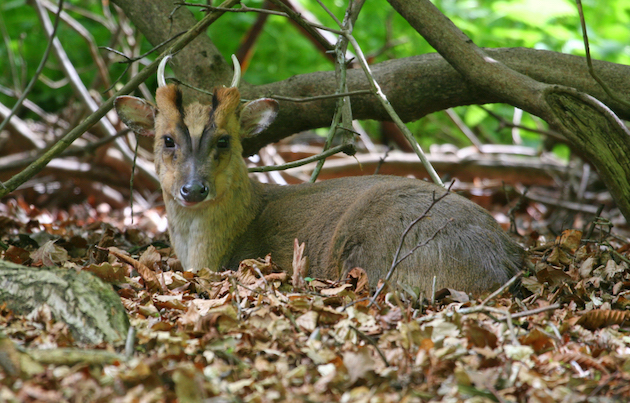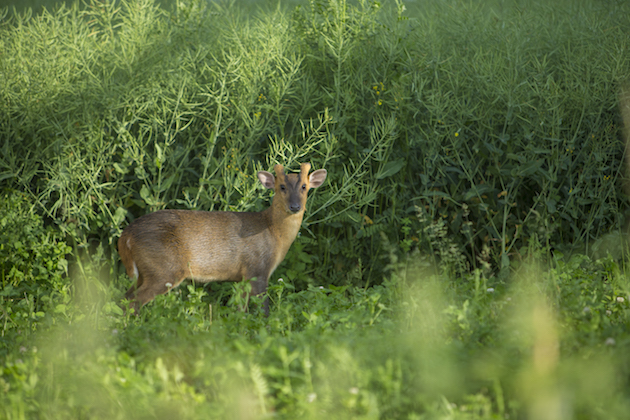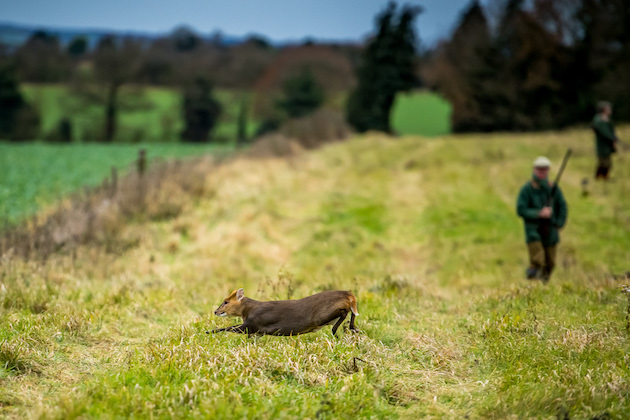Delicious recipe for muntjac steaks
This simple recipe cooks the perfect muntjac haunch steaks and is served with sauted potatoes, buttered spinach and peas
Win CENS ProFlex DX5 earplugs worth £1,149 – enter here
 USED 31 JAN 08 MUNTJAC REVIEW
USED 31 JAN 08 MUNTJAC REVIEW
Small, secretive and constantly on the move, the muntjac is a challenging quarry for the deer stalker. Little bigger than a springer spaniel, it offers a difficult target among the thick undergrowth that it prefers to live in. Although its antlers are simple things, usually not more than a couple of short spikes, it is not surprising that many seasoned stalkers still consider this small deer as something of a prize and its venison is considered by many to be some of the best available.
There are many different species of muntjac worldwide, although just how many is difficult to say as scientific opinion remains divided over the status of some as subspecies or species in their own right. They range in size between the giant or large-antlered muntjac from the Annamite mountains of Vietnam, standing the size of a fallow doe and only discovered as recently as 1994, and the diminutive leaf muntjac of Myanmar that weighs in at a mere 11kg. This species was also only discovered two decades ago; who knows if there are yet more still waiting to be recognised out there.
The muntjacs are all primitive forms of deer that have walked this planet in their present form for at least 15 million years. They get their name from the word meaning deer in the Sundanese language of Java and are also known as the ‘barking deer’ for their habit of keeping up a fox-like bark for long periods – over an hour at times.
The species we find in Britain is the Reeves’ or Chinese, named for John Reeves of the British East India Company who is credited with bringing the first specimens back to London in 1838. It was not until the 1890s, however, that serious introductions began, first within Woburn Park and then into the woods outside it. There were others but Woburn is generally accepted as the main point of entry to the UK. The slightly larger Indian muntjac was brought in at around the same time but did not thrive, and for many years some believed that the British muntjac might have been a hybrid of the two species, though we now know that this is not true.

The species found in Britain is the Reeves’, or Chinese, muntjac
The muntjacs spread across this country was slow at first. As recently as the 1970s, when the UK population was estimated at just around 5,000, the muntjac was still confined to the Midlands and East Anglia. Since then, numbers have rocketed with the population spreading across much of southern England and into parts of Wales and further north. Even more recently they have appeared in Northern Ireland, no doubt with the mostly illegal human assistance that also enabled much of their success in mainland Britain.
They are not always welcome here. Too many muntjac can have a negative effect on the understorey of woodland, eating rare plants or reducing the habitat needed by small mammals, nesting birds and other forms of life. Furthermore, many a gamekeeper, at that delicate stage of a drive when the birds have been pushed carefully forward to a flushing point, has despaired when a panicked muntjac has rushed through and put all of them into the air at the same time rather than in the desired smaller bunches.
Stalking on foot can be challenging but very rewarding when successful, though perhaps the best results are obtained by sitting quietly in a high seat and letting the deer move around you.
In addition to the difficulty of lining up a shot on this elusive quarry, their robust nature has long been recognised by those who have got to know them. Although it is now legal to shoot muntjac in England and Wales with a .22 centrefire with appropriate ballistic qualities, it would be a mistake to underestimate their toughness for such a small animal. Their skin, especially around the shoulder area, is unusually thick as befits an animal that does battle with sharp, canine tusks. A bullet has to penetrate this and then carry on expanding predictably through muscle and bone before reaching the vital organs.
This simple recipe cooks the perfect muntjac haunch steaks and is served with sauted potatoes, buttered spinach and peas
The diminutive muntjac deer arrived in Britain in 1900 as a plaything of the 11th Duke of Bedford who added…
Although most drop to the shot there are occasional surprises. Some memorable personal examples include one small doe, perfectly heart shot with a 150grn .308 soft point bullet, which managed a 40-yard dash before dropping; another, this time lung shot, made a full 70 yards while still having the strength to bury itself in a pile of brushwood before expiring.
I often wonder, if muntjac were the size of fallow deer, might we have to use calibres more suitable for big game to hunt these fascinating and testing little deer?

A muntjac goes pelting through the line
Get the latest news delivered direct to your door
Discover the ultimate companion for field sports enthusiasts with Shooting Times & Country Magazine, the UK’s leading weekly publication that has been at the forefront of shooting culture since 1882. Subscribers gain access to expert tips, comprehensive gear reviews, seasonal advice and a vibrant community of like-minded shooters.
Save on shop price when you subscribe with weekly issues featuring in-depth articles on gundog training, exclusive member offers and access to the digital back issue library. A Shooting Times & Country subscription is more than a magazine, don’t just read about the countryside; immerse yourself in its most authoritative and engaging publication.

